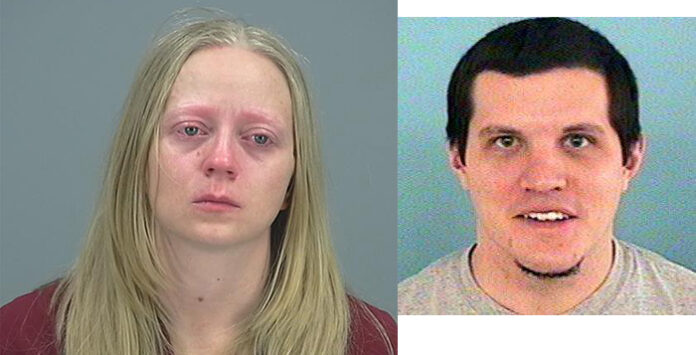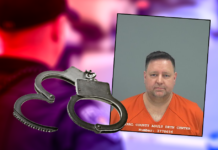Monday the jury heard closing arguments and received instructions in the murder trial of Kathryn Sinkevitch at Pinal County Superior Court.
Sinkevitch is charged with first-degree murder in the shooting death of 31-year-old Michael Agerter on Dec. 16, 2016. Agerter, her ex-boyfriend, was shot and killed in the garage of his rental home in Rancho El Dorado. The two lived separately but had an infant son together.
Prosecutors maintain the murder was because Sinkevitch did not want to share custody of the child with Agerter and the two were involved in a court battle, including DNA testing.
Agerter was murdered just hours after submitting DNA samples at Labcore.
“The defense wants you to believe it could have been anyone who have committed this murder,” prosecutor Shawn Jensvold told the jury. “The person who executed Michael would have known that he was coming home that afternoon. That person also must have had some severe hatred of Michael. Execution, that’s what happened. It doesn’t make sense that it was just anyone who did this.”
Jensvold said Sinkevitch intended to kill Agerter. “That is the essence of first-degree murder.”
He said it wasn’t just one piece of evidence in this case that showed guilt but a culmination of evidence.
Jensvold discussed motive and Agerter’s unwillingness to be a part of his son’s life in the beginning but later changing his mind.
Agerter even filed for custody, and this angered Sinkevitch, according to Jensvold.
“She was so consumed with hatred for Michael … She decided murder was her only option,” Jensvold said.
The prosecutor also discussed opportunity and knowledge. He said Sinkevitch knew Agerter was to undergo DNA testing and also knew his appointment was at 1:30 p.m. that day. She left from work to murder him just an hour after receiving information about when his DNA tests were to be done, according to Jensvold.
He discussed Sinkevitch’s plan to commit the murder, saying that was why she didn’t use her work identification badge to open doors that day and used a friend’s vehicle to commit the murder.
“Why was Kathryn so careless?” Jensvold asked the jury. “How reasonable was Kathryn’s mindset at this time? The bitterness stayed with Kathryn, and she wasn’t thinking clearly. A reasonable rational person doesn’t commit murder in the first place. He (Agerter) didn’t want her to know where he lived, and she hired a private investigator to get that information.”
He discussed DNA, soil sample and gunshot residue tests that were inconclusive.
He said the person on video at Agerter’s house was similar in stature to Sinkevitch, and the van in the video was also similar to the one Sinkevitch used that day.
Jensvold said Sinkevitch lied about what she did the day of the murder and said she didn’t take a lunch. She clearly is seen on camera leaving work that day for about three hours.
“Consider all the evidence in light of reason, common sense and experience,” Jensvold told the jury. “This can’t just be anyone. The real question is to flip it around – who else could it be besides the defendant? Who else had the motive? No one that we know of. None of the evidence has suggested that in any way. Who else had the opportunity? Who else knew specifically where Michael was going to be after returning from Labcore at 1:30? Who else would be so consumed with their hatred of Michael and self-absorbed to the point that they were willing to execute Michael and leave his family with a picture like this that they have to remember him by?”
He said normal people participate in the legal process when they have a custody problem like this.
“You don’t just go out and execute them in their garage,” Jensvold said in closing.
The defense then had their turn at closing arguments.
“This case is a circumstantial case. There is no direct evidence. There is no direct witness against Kathryn Sinkevitch,” defense attorney Bret Huggins said in his closing arguments.
Huggins said DNA is the gold standard of evidence and two DNA experts testified Sinkevitch’s DNA was not found anywhere on any evidence in the entire case.
Huggins said investigators never tested the van for gunshot residue, only two pieces of clothing that were in the van and only three microns of gunshot residue were found. A micro is 1/20 the size of a human hair he said.
Huggins said the state clearly has not proven their case against Sinkevitch.
The DNA that was found on a hair in the van didn’t match Sinkevitch, Huggins noted.
Huggins said there was no forensic firearms information available in the case. He said the soil samples in the case don’t match. He said they don’t know what size shoe made a shoeprint at the murder scene.
Huggins maintained that Sinkevitch didn’t drive the van seen at the murder scene in videos.
“Is that guilt beyond a reasonable doubt, is it?” Huggins asked the jury.
Huggins also questioned the credibility of the witnesses in this case.
“Some witnesses are just not credible,” Huggins said.
He said the case against Sinkevitch doesn’t fall together. Huggins concluded that Sinkevitch has been left with the burden to prove she didn’t commit the murder but in fact it is the state’s burden to prove she did it.
“Who caused the death of Michael Agerter?” Huggins said.
Huggins cautioned the jury to maintain their individual judgment about the case and not to be swayed by the thoughts of other jury members during deliberations.
“Too often juries become a committee of one,” Huggins said. “You get 12 people in there, a foreman is chosen and everybody else quits having any participation. The jury system doesn’t work that way. We need all of you to participate. We are entitled to your individual judgment.”
While giving the state’s final rebuttal, prosecutor David Ahl said there is no distinction between direct and circumstantial evidence.
“There’s no dispute the defendant owned a gun, yet no gun was ever found in her apartment,” Ahl said. “None of this evidence proves that Kaythryn Sinkevith wasn’t the shooter.”
He said there is no reasonable doubt who killed Agerter.
“There is no real possibility that it was someone else on Dec. 16 who jumped from that van to kill Michael Agerter,” Ahl told the jury. “For that to be true that it was someone else, Kathryn Sinkevitch would have had to have left work in Bridgett Hopkins’ van for no reason whatsoever after not clocking out, despite having her own car there. Just under an hour after leaving work her phone would have had to go dead. In this period, with her cellphone turned off for two hours, Michael Agerter was murdered. Michael Agerter was murdered just over an hour after she turned off her cellphone.”
Ahl said Sinkevitch had the motive and opportunity to kill Agerter.
“She planned it out and tried to hide her tracks,” Ahl said. “After it was over you have her telling lies that she was at work all day. You have her searching her computer on how to turn off 911 tracking on her phone. This defendant was not ready to share her child with its father because it would make her life more difficult.”
About 3 p.m. Monday, Judge Kevin D. White gave the jury their final instructions and sent them to deliberate Sinkevitch’s fate after three of the 15 jurors were selected as alternates and physically excused.





![Elena Trails releases home renderings An image of one of 56 elevation renderings submitted to Maricopa's planning department for the Elena Trails subdivison. The developer plans to construct 14 different floor plans, with four elevation styles per plan. [City of Maricopa]](https://www.inmaricopa.com/wp-content/uploads/2024/04/city-041724-elena-trails-rendering-218x150.jpg)

![Affordable apartments planned near ‘Restaurant Row’ A blue square highlights the area of the proposed affordable housing development and "Restaurant Row" sitting south of city hall and the Maricopa Police Department. Preliminary architectural drawings were not yet available. [City of Maricopa]](https://www.inmaricopa.com/wp-content/uploads/2024/04/041724-affordable-housing-project-restaurant-row-218x150.jpg)










![Elena Trails releases home renderings An image of one of 56 elevation renderings submitted to Maricopa's planning department for the Elena Trails subdivison. The developer plans to construct 14 different floor plans, with four elevation styles per plan. [City of Maricopa]](https://www.inmaricopa.com/wp-content/uploads/2024/04/city-041724-elena-trails-rendering-100x70.jpg)